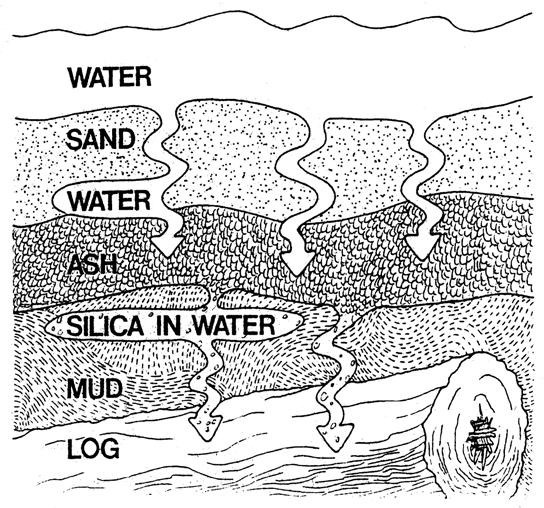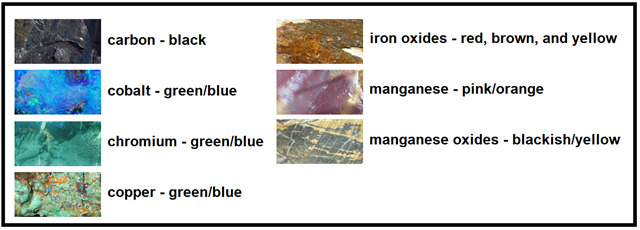This is an Earthcache – as such, there is no physical cache. Instead after examining the specimen at the posted coordinates you will answer 4 questions and message me the answers. The park is open daily from sunrise to sunset. All pets entering the park must be on a leash of six feet or less at all times while in Prince William Forest Park. For more information on entrance fees, park rules, hours of operation, or to learn the history of the park please visit this Prince William Forest link to go the the National Park Service park webpage.

At the posted coordinates you will find a specimen of petrified wood that is one of the largest ever found in the Commonwealth of Virginia. It was discovered in the early 1960s during the construction of Interstate 95. This species of petrified wood is believed to be that of Taxodium Distichum, or what we know as the Bald Cyprus. These trees are large, slow growing but long lived, deciduous conifers, which frequently grows from 100 to 120 feet.
VIRGINIA'S CRETACEOUS TROPICAL PARADISE
Much of the land forms we see today in Prince William Park were formed over 100 million years ago during the Mesozoic Era. During this time the climate was very warm and eastern Virginia was covered under a shallow sea. There were frequent anoxic (oxygen depleted) events in this era which caused the oceans to be more stagnant than they are today. Core samples from all over the world suggest that volcanic activity over the entire planet was at the highest levels of Earths climatic history.

The final period in the Mesozoic Era, the Cretaceous Period, ended approximately 66 million years ago and spanned a period of 79 million years. This period ended in catastrophe with near desolation of 85% of all life on the planet including most dinosaurs. This area of Virginia was largely swamps back then with tremendously high humidity and temperatures rising over 100° F daily. It was during the time when these Prince William Forest Park fossil trees were growing.
WHAT IS PETRIFIED WOOD?
Petrified wood is a fossil. It forms when plant material is buried by sediment and protected from decay caused by oxygen and biological organisms. It is the result of a tree or tree-like plants having completely transitioned to stone by the process of permineralization. All the organic plant material has been replaced with minerals like silica, calcite, and pyrite. The result is a fossil of the original woody material that often exhibits preserved details of the bark, wood, and cellular structures. Unlike other types of fossils which are typically impressions or compressions, petrified wood is a three-dimensional representation of the original organic material

In order for a plant to be fossilized, oxygen must be removed from the plants environment. In the case of Prince William Forest Park’s petrified wood, this occurred when the ancestral bald cypress trees fell over into the dense mud of their tropical environment. The lack of oxygen in this setting creates an atmosphere referred to as anaerobic. Anaerobic environments are necessary to fossilize the wood because most bacteria, insects and other decomposers require oxygen to decompose the organic material of the tree. Finally, through pressure and time, other minerals such as silica replace the cell material in the tree and are hardened into the petrified trees we see today.
Elements such as manganese, iron and copper in the water/mud during the petrifaction process give petrified wood a variety of color ranges. Pure quartz crystals are colorless, but when contaminants are added to the process the crystals take on a yellow, red, or other tint.

LOGGING REQUIREMENTS:
To log this Earthcache: Read the geology lesson above. Answer all four questions posted below. Answers can be sent via e-mail or messenger contacts on my Geocaching profile. Do not post the answers to the questions in your logs. Photographs of the park and the petrified specimen are encouraged but please restrain from posting direct spoilers of the taproot.
QUESTION 1. Touch the Petrified Wood. Describe the texture? (Is it smooth? Coarse? Does it feel like a regular tree?)
QUESTION 2. Petrified wood can preserve the original structure of the stem in all its detail, down to the microscopic level. Structures such as tree rings and the various tissues are often observed features. By observing the visible rings on this 24" diameter specimen, what is your estimate to how old this tree was when it fell?
Use this to help with your answer: AGE = (Radius – Bark) x (rings per inch)
The ring density is approximately ____ rings per inch. With a radius of 12 inches, subtracting 2 inches of bark, that would give 10 inches of tree left, placing the approximate age of the tree at around ___ years of age before falling. SO... the simple math you have to do is count the amount of rings you see in a one inch section (which should be a single digit number), and multiply that by 10.
QUESTION 3. An examination of the base of the large trunk section of the fossil tree easily demonstrates the taproot of the tree. Observe the crystal formations in the inner taproot. Which of the elements mentioned in the earthcache description can you identify in the crystals?

QUESTION 4. There is another earthcache nearby that teaches about the Gold-Pyrite Belt that runs under Prince William Forest Park. Pyrite (also known as “Fools Gold”) is composed of iron and sulfide, and is a brass-yellow color that contains streaks of black. The photograph above contains a specimen of petrified wood with pyrite in it. Observe the specimen at the posted coordinates. Do you see any evidence of pyrite in this petrified wood?

Prince William Forest Park Entrance Fees as of January 2020:
| $20.00 |
per vehicle, 7 consecutive days |
Valid for 7 consecutive days. |
| $15.00 |
per motorcycle, 7 consecutive days |
Valid for 7 consecutive days. |
| $10.00 |
Individual (walking, cycling) |
Valid for 7 consecutive days. |
| $35.00 |
Annual Pass, provides entry for pass holder and occupants of a single personal vehicle (capacity of 14 passengers or less). |
Valid for current year. |
NOTE: Starting May 1, 2023, Prince William Forest Park will no longer accept cash for park entrance fees. Entrance fees and passes can be purchased with credit/debit card, mobile payment app, or online through recreation.gov.

Awesnap has earned GSA's highest level:
 Permission to place this earthcache was granted by:
Permission to place this earthcache was granted by:
Chris Alford
Chief of Interpretation
Prince William Forest Park

REFERENCES:
1. A Petrified Prospectus, A Scientific Look Into the Petrified Wood at Prince William Forest Park, U.S. Department of the Interior 98-326,Eric Junger, 2008, p. 5-9.
2. What is Petrified Wood? How Does it Form?, Hobart M. King, Ph.D., Geology.com, https://geology.com/stories/13/petrified-wood/
3. Petrified Wood Colors and Petrification, Scienceviews.com, http://scienceviews.com/parks/woodcolors.html
4. Virginia Geologic Time Scale, THE GEOLOGY OF VIRGINIA, http://geology.blogs.wm.edu